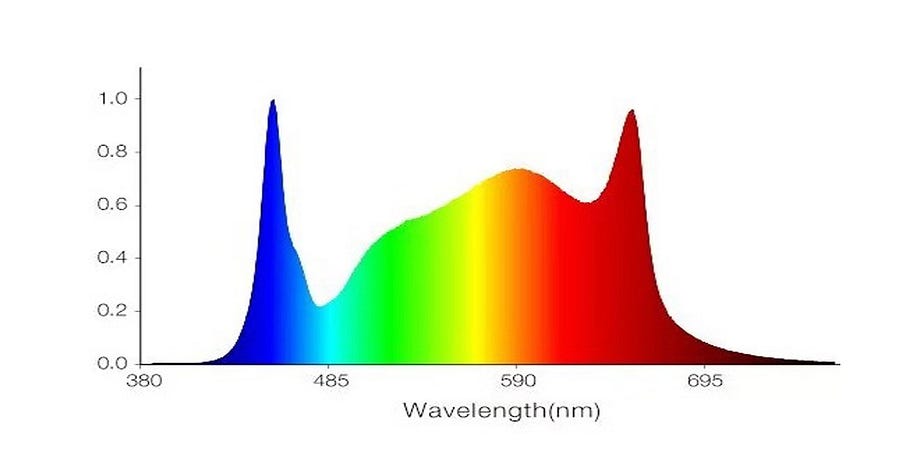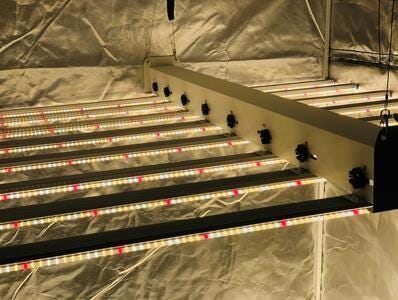What Color Light Is Best For Plant Growth
All plants need light to grow, but scientists have found out that different colors affect a plant’s growth differently.
And although sunlight seems white because it has all the colors from the light spectrum, white light isn’t the answer to the question — what color light do plants grow best in?
So today we’ll talk more about which types of colors are out there and how do different colors of light affect plant growth. In short, you will learn what color of light is best for plant growth.
What is a Color Spectrum?

Plants are genetically programmed to grow using sun light, which we consider to be white light, or yellowish-white light. This light looks white because it contains all of the colors of a rainbow, and when these colors are all mixed together they look white.
A color spectrum is a graphical display of each of the colors in the light.
Scientists use wavelength numbers to refer to the colors instead of color names, which is a much more accurate way to measure the color. So a red might have a wavelength of 630 or 660. Both of these look red to us, but they are actually different colors.
Grow lights that use florescent bulbs, refer to the color of the bulb as cool white (has more blue), or warm white (has more red). That was useful for florescent lights, but such designations do not work well for LED lights. When it comes to LED it is more accurate to talk in terms of wavelengths and to display the actual color spectrum.
Which Colors do Plants Use?
Plants use light mostly for photosynthesis and this is done with specific chemicals in the leaves. Examples of the more important chemicals include Chlorophyll A and B. In the absorbance spectrum (measures how much light is absorbed) you can clearly see the peaks in the blue and red regions which means that these colors are used for photosynthesis.
Almost no light is absorbed in the green range.
This has led to the incorrect conclusion that plants only need blue and red light.
The Myth of Blue and Red

The idea that plants grow well with only blue and red light is in fact a myth. The above color spectrum is for purified chlorophyll in a test tube and it does not show you what happens in a plant leaf. Photosynthesis is more complex and involves other chemicals like carotene and xanthophyll. A color spectrum of the light absorbed by the whole leaf shows that plants actually use a wider range of wavelengths, including green.
It is true that blue and red are important and represent most of the light used by plants, but other colors, including green and yellow are also used for photosynthesis.
What color light is best for plant growth
Plants use sunlight to make energy. The process by which they do this is called photosynthesis. Chlorophyll in the plant is the pigment that absorbs light. Light is made up of three different colors: red, blue and green. The reason that green plants appear that color is that they reflect that color in the light spectrum. In other words, the chlorophyll in the plant absorbs the red and blue light much more readily than the green light.
How does green light affect plant growth
Professor Kevin Folta of the University of Florida has produced experiments in which plants’ development, especially as seedlings, is actually harmed by green light. Specifically, he found that green light can reverse the stem growth in certain plants.
Daniel Mosquin, the education and technology manager for the University of British Columbia Botanical Garden and Centre for Plant Research, also gave as his opinion that green light, though it might not cause plants to actually die, will have detrimental effects because of the lack of photosynthesis that will result. The red and blue lights are the ones that produce the energy needed for photosynthesis and plant growth and development.
How does red light affect plant growth and why is red light good for plants
Red light can convey caution or danger or stopping at intersections, but for plants red light is highly effective at regulating growth and development. Within the photosynthetically active waveband (400 to 700 nm), sunlight emits roughly similar amounts of blue, green and red light. With conventional electric lamps, the proportion of light is somewhat similar, ranging from 24 percent for coolwhite fluorescent to 40 percent for high-pressure sodium (HPS) lamps. With arrays of light-emitting diodes (LEDs), the proportion of red light can range from 0 to 100 percent. Many commercial LED fixtures developed for plant growth applications emit a large proportion of red light, with 75 to 85 percent of the light spectrum commonly emitted in the red region. The primary reasons why LED fixtures emit a lot of red are 1) red LEDs are among the most efficient at converting electricity into photosynthetic photons, 2) chlorophyll strongly absorbs red light, thus it is effective at photosynthesis, and 3) red LEDs are relatively inexpensive. Let’s take a brief look at how red light influences plant growth and development.
Red Vs. Green
Experiments have been recorded showing the difference between plants grown under red and green lights, respectively. A simple demonstration of this was at the 2004 California State Fair, where Nichele R. Lee presented a project with the title: “What Color Light Helps Plants Grow?” The conclusion was that the red light grew the stronger plants, though it was noted that the green light had plants that germinated more quickly.
A study of the effects of red and green light on plants was conducted by Lewis H. Flint and Charles F. Moreland at Louisiana State University. The pair studied and compared plant growth with red and green lights, but specifically simple leaf development of intact and decapitated bean plants. Decapitating the bean plants reversed some of the effects the different colors of light were having on the plants.
How does white light affect plant growth
White light is great for plants. I mean, think about it. What color is sunlight?
It only makes sense that providing artificial light that has a similar spectrum to natural sunlight would work well for plants.
Plants need mostly red and blue light for photosynthesis. White light, like sunlight, contains large amounts of red and blue wavelengths. But it also contains large amounts of green, yellow and every other color.
Because plants absorb primarily red and blue light, those other colors go mostly unused. In the case of the sun, that doesn’t really matter, since it is an endless energy source.
How does yellow light affect plant growth
Plants make the least use of yellow light, but they do use it as well. Give them some, but they won’t need much. Just keep in mind yellow light exhibit less growth for plants compared to blue and red light
How does Violet light affect plant growth
On its own, violet light has a limited effect on plant growth, but it is very useful when combined with red and blue light. The addition of violet light enhances the color, taste, and smell of plants. It does enhance the color, taste, and aroma of plants.
How does orange light affect plant growth
A plant can have one photopigment devoted to absorbing deep blue, another devoted to absorbing yellow, another for orange, and another for red.Orange light is used like red light. It is not the ideal wavelength that a darker red is, but it is still absorbed like red. You want to provide some orange light, but more light that is a darker red than orange.
How to Choose the Right Type of Light?
Now that you are familiar with what color lights do plants grow best in, let’s talk about how to choose the right type of light for your plants.
There are 4 different light types that you can use for your plants if you want to grow them indoors.
Each type has a different application, but some light types can be used for most plant species.
Let’s see what these types are.
High-Intensity Discharge Lights
HID grow lights have an amazing light output and they’re regarded as lights with the best brightness. They are also used to cover larger areas of crops and are mainly used in grow tents.
Now, HID lights use special gas-filled bulbs that primarily come in white or yellow color, and as we’ve already said, white-color lights are perfect for growing most plant types as they contain red, green, and blue.
However, you can also find HID lights in different colors such as violet, blue, red, and so on.
So you want to use HID lights if you have a larger indoor plantation, or a grow tent, or a grow room where you need lots of lighting coverage, then they’re your safest bet.
Fluorescent Lights
Fluorescent grow lights are also a great choice for most gardeners as they last a very long time and they also produce a lot of blue light, which is beneficial for plant growth.
Apart from blue, they also produce other colors of the color spectrum, but not all, so they’re best for leafy plants which have a lot of foliage.
Some gardeners prefer fluorescent lights because they last long, don’t emit much heat and they also save a lot of energy, not to mention that they can cover a lot of space.
LED Grow Lights

Most LED grow lights can produce white, red, or blue color and they’re quite popular among gardeners because they’re cheap, easy to find and provide the plants all the necessary light colors.
This means that they’re suitable for most plants, and what’s great is that you can determine how much light you need and simply add or remove the LED light bulbs as you wish.
You can use any LED lights you can find, and even make your own DIY LED lights at home for just a few bucks.
Incandescent Lights
As a gardener, you want to stay away from incandescent lights as they’re mostly used for looks rather than function. There’s a reason no one uses them anymore even for house lighting.
This is because incandescent lights mainly use yellow, or warm white light which doesn’t really provide your plants the best lighting and they’re also quite dimmer than other light types.
Some gardeners use them because they’re quite inexpensive, but in the end, they won’t make your plants grow any faster or better.
Conclusion
What is the best color spectrum for LED lights? It should be close to the spectra used by plants. Lots of blue and red, and some green and yellow. Add some near IR and maybe even near UV and it is even better.
Don’t worry about matching the sun or white light.
I think it is important to see the output spectra of a light before you buy, but most manufacturers don’t show these. The new proposed labels for LED grow lights, will show PPFD (called PFD) for various ranges of wavelengths, including the PAR range.
Comparing PPFD values is the next best thing. A higher PPFD will provide more light for plant growth.
评论
发表评论